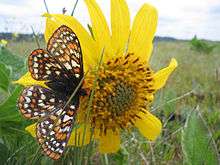Euphydryas editha taylori
Euphydryas editha taylori, the Whulge checkerspot or Taylor's checkerspot, is a butterfly native to an area of the northwestern United States and Vancouver Island.
| Euphydryas editha taylori | |
|---|---|
 | |
| Scientific classification | |
| Kingdom: | Animalia |
| Phylum: | Arthropoda |
| Class: | Insecta |
| Order: | Lepidoptera |
| Family: | Nymphalidae |
| Genus: | Euphydryas |
| Species: | |
| Subspecies: | E. e. taylori |
| Trinomial name | |
| Euphydryas editha taylori (W.H. Edwards, 1888) | |
Description
Taylor's checkerspot is the darkest subspecies of the genus Euphydryas. It is a subspecies of Edith's checkerspot. This butterfly has a wingspan of less than 2.25 inches (57 mm). It gets its name from the checkered color pattern on its wings that consist of black, orange and white coloring.[1] Taylor's checkerspot once ranged from the Willamette Valley in Oregon to Vancouver Island in British Columbia.
Conservation status
The Taylor's checkerspot butterfly is at extreme risk of going extinct.[1] It was listed as endangered under the U.S. Endangered Species Act in 2013.[2] In 2006, it was listed as state-endangered in Washington, where an active conservation program is underway. In Oregon Taylor's checkerspot is on the Threatened and Endangered Species list, but receives no protection under state statute. Before its dramatic decline Taylor's checkerspot was documented at more than seventy sites, but is currently found only at twelve sites in Washington and two in Oregon.[1] It is currently listed as endangered in Canada, owing to the recent discovery of populations on Denman Island.[3]
Threats
The biggest threat to its survival is the loss of prairie habitat due to contemporary settlement. Since the arrival of European Americans, more than 99% of the lowland prairies has been destroyed. The reason for this is that prairies are prime locations for agriculture as well as development of all types due to the lack of trees and flat topography.[4] Along with habitat loss the subspecies is impacted by pesticide use that makes their plight even worse.[5] Increased risk of harm due to drought is another major concern since they are now stuck on these patches of habitat with no chance to migrate to more suitable places.
References
- S. H. Black & D. M. Vaughan (May 2005). "Species profile: Euphydryas editha taylori" (PDF). In M. D. Shepherd, D. M. Vaughan & S. H. Black (ed.). Red List of Pollinator Insects of North America. CD-ROM Version 1. Portland, Oregon: Xerces Society.
- https://www.federalregister.gov/articles/2013/10/03/2013-23552/endangered-and-threatened-wildlife-and-plants-designation-of-critical-habitat-for-taylors
- http://publications.gc.ca/collections/collection_2011/ec/CW69-14-206-2011-eng.pdf
- Paula Bock (July 15, 2007). "Butterflies aren't free. Saving the planet one bug at a time" (PDF). Seattle Times.
- Cheryl Fimbel (2004). "Habitat enhancement for rare butterflies on Fort Lewis prairies" (PDF). South Puget Sound Prairie Landscape Working Group. Archived from the original (PDF) on 2010-12-29. Retrieved 2011-03-19. Cite journal requires
|journal=(help)
Further reading
- Glassberg, Jeffrey Butterflies through Binoculars: The West (2001)
- Guppy, Crispin S. and Shepard, Jon H. Butterflies of British Columbia (2001)
- James, David G. and Nunnallee, David Life Histories of Cascadia Butterflies (2011)
- Pelham, Jonathan Catalogue of the Butterflies of the United States and Canada (2008)
- Pyle, Robert Michael The Butterflies of Cascadia (2002)
